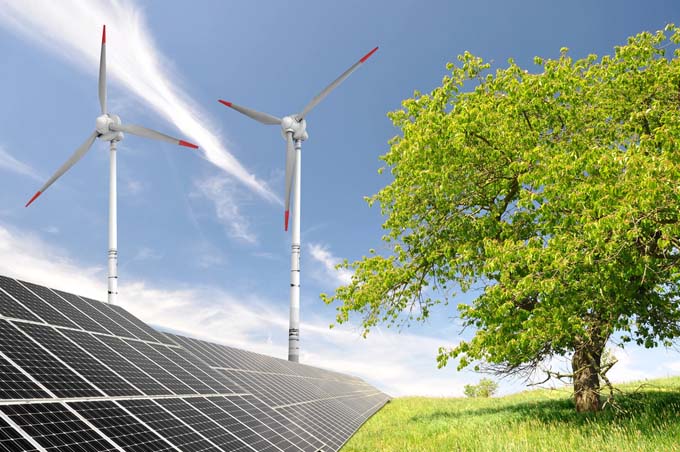Forward-looking fuel cells: Power and heat with biogas
One particularly innovative technology is currently attracting attention not only for cars but also for supplying energy to houses: the fuel cell. Everyone is talking about it, but very few people know exactly what is behind it.

How does a fuel cell plant work? Similar to a conventional combined heat and power plant (CHP), a fuel cell system, unlike other heating systems, simultaneously generates heat and electricity from the energy source, in this case biogas. In this case, the biogas serves as the supplier of the energy to trigger a chemical reaction, which is necessary to operate the heating and electricity consumers.
The fuel cell essentially consists of an anode and a cathode separated by an electrolyte with a solid, ion-permeable membrane. This creates the basis for the necessary chemical reaction between oxygen (O) and hydrogen (H) to form water (H2O). In this process, the biogas serves as the supplier of the hydrogen. What exactly happens when oxygen and hydrogen react? This is called cold combustion. The membrane forces the hydrogen to split into protons and electrons. The protons can travel through the membrane, while the electrons travel to the cathode, generating electricity. At the same time, the reaction of the remaining particles in the cathode to form water generates process heat as heating energy.
The fuel cell was invented as early as 1838 by Christian Friedrich Schönbein. But its success was initially thwarted by another invention: Werner Siemens' electric motor revolutionized energy technology in 1856, and it would be almost 100 years before the fuel cell belatedly achieved a successful breakthrough in space travel. This was followed by the development of further applications in vehicle and heating technology.
Current status of fuel cell technology
Since the 1990s, intensive work has been carried out in Switzerland on the development of fuel cell devices to generate electricity and heat for the private sector. Winterthur is considered the center of Swiss fuel cell research. Here, preference is given to the high-temperature cell technology SOFC with an operating temperature of about 850 ºC, while in Japan mainly the low-temperature cells PEMFC are used, which operate at 40 to 160 degrees Celsius.
Companies around the world are working flat out to reduce the disadvantage of the high investment costs involved in acquiring the new technology. The fuel cell gobbles up the lion's share of the price. There are two reasons for this: The very high manufacturing costs and the still very small number of units, which is far from mass production. For this reason, manufacturers in Switzerland are trying to increase acceptance among homeowners by offering incentives and emphasizing the special advantages of this environmentally friendly energy source. In addition, the Swiss gas industry is promoting the use of this energy source, which is ideal for operating fuel cell systems, by subsidizing biogas.
In Switzerland in particular, biogas has achieved a high status as a regenerative energy. In contrast to its fossil variant natural gas, biogas can theoretically be produced indefinitely and also scores points for clean combustion with significantly lower pollutant content. Therefore, biogas is the ideal driving energy for a fuel cell-based heating system in the private sector.
What does the new technology cost?
The (still) very high initial costs have already been mentioned, and unfortunately fuel cell systems are not (yet) subsidized by the state in Switzerland at the moment. This results in a significantly lower number of installed systems of only a few hundred in Switzerland, in contrast to neighboring Germany, where they are subsidized with up to 13,000 Swiss francs per household. It is to be hoped that a subsidy program will also support this forward-looking and environmentally friendly technology in this country. With average system prices of around 30,000 to 50,000 Swiss francs, depending on size and design, the technology is still a long way from becoming widespread.
Today, the overall efficiency already reaches almost 90 percent. This is a remarkable result and could even be increased in the future if the electricity required for electrolysis were generated by a photovoltaic system and not by gas. However, the necessary technology for this is not yet available at affordable prices. Furthermore, a supporting gas heating system has to be integrated at the moment, but this is already included in the prices mentioned above. The efficiency of the system is significantly improved by the installation of a buffer storage tank.
A future outlook
Fuel cell technology for private households is still a young form of energy generation; until 2015, fuel cell systems were only used as prototypes in research projects in model houses. From this perspective, their diffusion has developed rapidly, from virtually zero five years ago to a few hundred in 2020, and significantly more in other countries. This is helping to gradually lower the manufacturing price per unit and make this energy alternative marketable.
A major advantage in favor of fuel cell technology is the versatility and flexibility of the primary energy required. In fact, not only natural gas can be used to produce hydrogen, but also other energy sources generated from renewable sources. All that is needed is an energy supply that releases the abundant hydrogen from its stable chemical bond with another element. Suitable environmentally friendly primary energies are: Biogas, bioethanol, electricity from wind energy and electricity from solar energy.
One thing is clear: anyone who installs a fuel cell technology system today to cover their home's heating energy and electricity consumption is also investing in the future. These modern all-round boilers are connected to the Internet as standard, so that any irregularities can not only be registered simultaneously, but even corrected by remote maintenance. All this makes fuel cell systems the energy technology of the 21st century.
Author: Maximilian Pawelzik, Baufritz AG, Eco house pioneer









